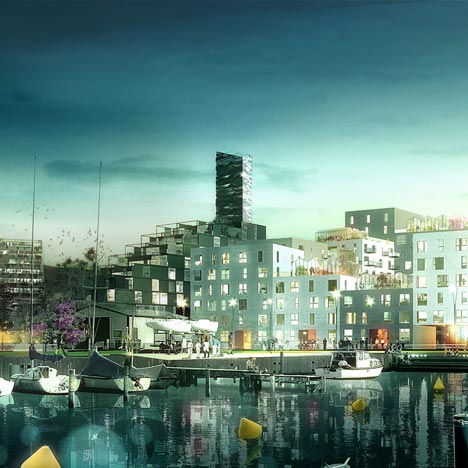Danish architects ADEPT and Luplau & Poulsen have won a competition to design harbour-side housing blocks in their hometown of Aarhus.
The proposed development, collectively titled the City in the Building, will include an assortment of uncomplicated brick buildings that surround a shared courtyard.
Shorter buildings located beside the water will accommodate apartments for families and senior citizens, while taller buildings behind will house students.
All residences are planned to be dual-aspect and every block will contain some sea-facing homes.
Greenhouses will be located on the roofs, beside solar panel arrays and rainwater collection units.
The project is due to complete in December 2013.
Other competition wins from ADEPT include a skyscraper of stacked cubes - see all our stories about the architects here.
Here are some more words from ADEPT:
ADEPT and Luplau & Poulsen win 12,000 m2 residential project at Aarhus Harbour
Common greenhouses on the roof tops, adjacent terraces overlooking the bay of Aarhus, and a sheltered green courtyard - all in close proximity to downtown Aarhus. This is the essence of Brabrand Housing Association’s new residential complex that breaks with both the port’s massive scale, and present iconic building tendencies. The project is expected to be completed for inauguration in December 2013.
Wednesday November 2nd the Deputy Mayor Laura Hay revealed the winners of the competition at a reception at Aarhus City Hall. The winning team consists of the architects ADEPT and LUPLAU & POULSEN, turn-key contractor Dansk Boligbyg and NIRAS Consulting Engineers. The team has designed a project entitled The Port Dwellings - Housing for All at Harbour North, that consists of 238 public dwellings distributed between 83 apartments for families and +55 aged seniors, and 155 student-housing units.
The architects have taken the best aspects of the city's existing block structure and reinterpreted it, providing a modern and sustainable expression on the waterfront in Aarhus Nordhavn. The simple building arrangement is complemented by shared greenhouses on the roof, varied building heights and sustainable initiatives that make the new dwellings robust and future-proof. The housing structure adapts to its context that, on the one hand, consists of large, industrial scale and on the other, a smaller and intimate scale with a lively maritime atmosphere.
“Placing the building volumes along the edge of the site proved to be highly appropriate for the location. It gathers the dwellings around a large green courtyard sheltered from the wind and creates the best sun and daylighting conditions for the apartments,” says Martin Laursen, partner of ADEPT. The development is being realized predominantly in brick, dropping in building height towards the water and the marina. As a consequence, the apartments furthest from the water, the youth homes share the extensive views. In addition, the building structure is subdivided into smaller buildings, marked by varying heights and subtle changes in façade expression. “The building's division into smaller buildings relates to the human scale and creates affinities between the residents and the individual 'town house’,” says Simon Lyager Poulsen, ADEPT’s project architect on the Port Dwellings.
The project differs from the bulk of existing and proposed port projects in that it does not attempt to be a major iconic building – an aspect of the scheme remarked upon positively by the developer and competition jury. Brabrand Housing Association has deliberately chosen to focus on a building that inserts itself in the port in a humble manner, challenging the large scale of the context by addressing the scale of inhabitants’ daily lives.
The family apartments are located in the lowest buildings, in close proximity to the water and the intimate scale of the marina. In this way children and parents have convenient access to activities at the waters edge, the forest and the inner courtyard. In addition, all roof surfaces are designed for shared-use amongst residents. The sunny roof surfaces are activated with greenhouses, common areas and living terraces with excellent views of the city, forest and bay. The remaining roofs are established as green surfaces both for collecting rain water and supporting solar panel arrays.
The settlement is a ‘zero-energy building,’ which, with it’s solar panels and greenhouses, takes more advanced steps toward meeting future energy requirements than those currently formulated by the municipality and the state government. Brabrand Housing Association expects the future settlement to meet the energy requirements of 2025 – an energy class yet to be formulated. At the same time the dwellings can be built within the allocated budget, which allows rents to be competitive.
Each apartment is lit from two sides and has private outdoor spaces overlooking the water and the common courtyard. The units range in size between 78m2 and 115 m2 and consist of 2, 3, 4 and 5 room apartments. Robust and flexible plan layouts ensure live-ability over the years, across generations and changing architectural trends. In these terms, the winning project offers both a robust, simple and coherent project as well as a varied and lively architecture.
Throughout the competition process, ADEPT and LUPLAU & POULSEN have enjoyed a close collaboration. LUPLAU & POULSEN has in recent years been responsible for several new Brabrand Housing Association projects. “We are delighted to continue the strong cooperation with Brabrand Housing Association,” says Jørn Lyager Poulsen, partner responsible for the housing project at LUPLAU & POULSEN. The three partners in ADEPT, who all come from Aarhus are, like LUPLAU & POULSEN, excited about the opportunity to build in their hometown and to contribute to the development of the waterfront in Aarhus.

